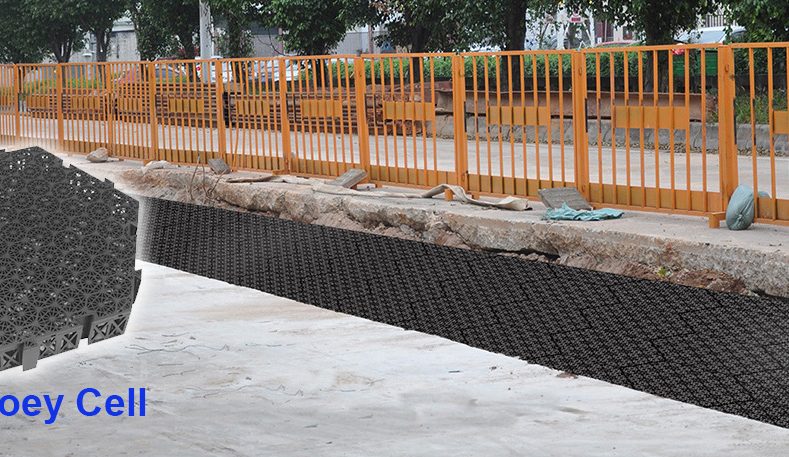In the ever-increasing pace of urbanization, ground stability has become a core challenge in city planning and construction. From supporting high-rise buildings to maintaining effective drainage systems, every aspect highlights the importance of a solid foundation. Against this backdrop, Hoensoey Cell, as an innovative solution for foundations, offers effective methods to address these challenges.
Challenges of Ground Stability:
Facing urbanization and increased building density, ground stability has become a key challenge for city infrastructure.
1. Impact of Urbanization and Building Density:
– With the acceleration of urbanization, the increase in building density exerts significant pressure on ground stability, especially in city centers and commercial areas that need to support high-rise buildings and heavy traffic.
– In these high-density areas, the natural carrying capacity of the land is challenged, sometimes unable to effectively support the weight of new constructions, leading to ground subsidence, tilting of buildings, or even collapse.
2. Soil Erosion and Subsidence Caused by Water and Groundwater Flow:
– The construction of hardened surfaces and drainage systems in urban areas disrupts the natural absorption and discharge of water. The inability of rainwater and groundwater to permeate effectively leads to water accumulation in certain areas.
– Prolonged water accumulation causes soil softening and structural weakening, leading to soil erosion and subsidence, affecting ground stability, and potentially damaging underground facilities and pipelines.
3. Challenges of Complex Terrain and Unstable Soil Conditions:
– The diversity of geological conditions, such as silty soil in coastal areas, rocky substrates in mountainous regions, or sandy soils in river valleys, affects bearing capacity and stability differently.
– In some areas with soft or porous soil, conventional foundation solutions may be ineffective, requiring specialized engineering techniques to ensure the stability of buildings and infrastructure.
As urbanization progresses and environmental challenges increase, finding infrastructure solutions that can adapt to different geological conditions, withstand high-density building pressure, and effectively manage groundwater flow becomes increasingly important. Novel Drainage Cells, as an innovative foundation solution, is gaining more attention in modern city planning.
Application Advantages of Hoensoey Geocellulars:
1. Principles of High Compressive Strength:
– Geocellular Units’ hexagonal design offers excellent geometric stability. This shape evenly disperses pressure in all directions, reducing concentrated stress points, thus enhancing overall compressive strength.
– The material used, recycled polypropylene (PP), has high strength and durability, allowing Geocellular for Shallow Drainage Solution units to maintain shape and structure even under long-term load.
2. Improved Drainage Conditions:
– Hoensoey Stormwater Modules’ structural design allows water to pass through quickly, effectively promoting groundwater permeation and discharge. This drainage mechanism reduces water accumulation underground, preventing soil softening and erosion due to excessive moisture.
– At the same time, this drainage method also helps maintain the natural moisture balance of the soil, equally important for preventing drought and soil hardening.
3. Enhanced Load-Bearing Capacity of Foundations:
– The interlocking connection between Hoensoey Modular Crates units increases the overall stability of the structure. Laying a Heavy-duty Drainage Cell layer on the foundation forms a solid support network, effectively dispersing and bearing the weight above.
– Moreover, the uniform support surface provided by Rainwater Storage Crates reduces the risk of uneven subsidence of the foundation, especially in areas with suboptimal soil conditions or under heavy structures.
4. Strong Design Adaptability:
– Hoensoey Stormwater Modules‘ design allows it to adapt to various geological conditions. Whether it’s soft sand, clay, or hard rock substrates, Heavy-duty Drainage Cells can effectively disperse pressure, reducing reliance on specific soil types.
– Its modular design also means that the layout and thickness can be adjusted according to the specific needs of the project, offering highly customized solutions.
Case Studies and Analysis:
– In a large public square renovation project, Novel Drainage Cells was used to enhance ground stability. The square needed to withstand heavy pedestrian traffic and periodic heavy event facilities, and traditional foundation layers could not meet the demand. Using Geocellular Units, engineers successfully resolved issues caused by uneven ground subsidence, such as cracks and uneven surfaces.
– In a residential project in a riverside area, traditional foundation solutions were problematic due to high groundwater levels. The use of Rainwater Storage Crates not only improved the stability of the foundation but also effectively controlled the impact of groundwater.
The Role of Geocellular for Shallow Drainage Solution in Future Urban Infrastructure:
Facing the challenges brought by rapid urbanization, Hoensoey Modular Crates is not only a solution to ground stability issues but also a crucial tool for promoting sustainable urban development. By achieving effective rainwater management and providing strong foundation support, Hoensoey Geocellulars help build a more resilient, safe, and eco-friendly materials and water resource management capabilities position it as a key component in sustainable urban development. In a world grappling with climate change and resource scarcity, adopting environmentally responsible solutions like Hoensoey Cell is vital for reducing the ecological footprint of cities.
– Enhancing Urban Safety and Comfort: By improving ground stability, Rainwater Storage Crates not only protects infrastructure and buildings from damage but also offers a safer and more comfortable living environment for urban residents. Its application in public squares, residential areas, or business centers significantly enhances the quality and utility of urban spaces.
– Future-Oriented Urban Planning: As urbanization continues, innovative infrastructure solutions will play an increasingly important role. Hoensoey Geocellulars, as a pioneer in this trend, addresses current challenges and provides a flexible, sustainable path for future city development.
In summary, Hoensoey Cell is not just a response to current urban infrastructure challenges; it represents a step towards more sustainable, adaptable, and environmentally friendly urban planning. By embracing innovative technologies like Hoensoey Stormwater Modules, we can look forward to building more stable, safe, and green cities of the future.



Leave a comment